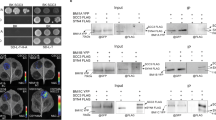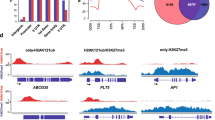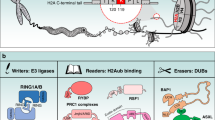Abstract
Histone ubiquitination plays a critical role in the regulation of transcription, and histone H2B monoubiquitination (H2Bub1) is mainly associated with transcriptional activation. Recent studies in yeast, humans, and Arabidopsis have revealed the conservation of chromatin modification via H2Bub1 during evolution. Rad6-Bre1 and their homologs are responsible for H2B monoubiquitination in diverse eukaryotic organisms, and the PAF complex is required for H2Bub1 to proceed. H2Bub1 is involved in many developmental processes in yeast, humans, and Arabidopsis, and it activates gene transcription by regulating the H3K4 methylation state. Notably, the level of H3K4 methylation is entirely dependent on H2Bub1 in yeast and humans, whereas the H3K4 methylation level of only a small number of genes in Arabidopsis is dependent on H2Bub1. In this review, we summarize the enzymes involved in H2B monoubiquitination and deubiquitination, and discuss the biologic functions of H2Bub1 in different organisms. In addition, we focus on recent advances in our understanding of the molecular mechanisms that enable H2Bub1 to perform its function.
Similar content being viewed by others
References
Briggs S D, Xiao T, Sun Z W, Caldwell J A, Shabanowitz J, Hunt D F, Allis C D, Strahl B D (2002). Gene silencing: trans-histone regulatory pathway in chromatin. Nature, 418(6897): 498
Cao Y, Dai Y, Cui S J, Ma L G (2008). Histone H2B monoubiquitination in the chromatin of FLOWERING LOCUS C regulates flowering time in Arabidopsis. Plant Cell, 20: 2586–2602
Chandrasekharan M B, Huang F, Chen Y C, Sun Z W (2010b). Histone H2B C-terminal helix mediates trans-histone H3K4 methylation independent of H2B ubiquitination. Mol Cell Biol, 30(13): 3216–3232
Chandrasekharan M B, Huang F, Sun Z W (2009). Ubiquitination of histone H2B regulates chromatin dynamics by enhancing nucleosome stability. Proc Natl Acad Sci USA, 106(39): 16686–16691
Chandrasekharan M B, Huang F, Sun Z W (2010a). Histone H2B ubiquitination and beyond: Regulation of nucleosome stability, chromatin dynamics and the trans-histone H3 methylation. Epigenetics, 5(6): 460–468
Daniel J A, Torok M S, Sun Z W, Schieltz D, Allis C D, Yates J R 3rd, Grant P A (2004). Deubiquitination of histone H2B by a yeast acetyltransferase complex regulates transcription. J Biol Chem, 279(3): 1867–1871
Dhawan R, Luo H, Foerster A M, Abuqamar S, Du H N, Briggs S D, Scheid O M, Mengiste T (2009). HISTONE MONOUBIQUITINATION1 interacts with a subunit of the mediator complex and regulates defense against necrotrophic fungal pathogens in Arabidopsis. Plant Cell, 21(3): 1000–1019
Dover J, Schneider J, Tawiah-Boateng M A, Wood A, Dean K, Johnston M, Shilatifard A (2002). Methylation of histone H3 by COMPASS requires ubiquitination of histone H2B by Rad6. J Biol Chem, 277(32): 28368–28371
Emre N C, Ingvarsdottir K, Wyce A, Wood A, Krogan N J, Henry K W, Li K, Marmorstein R, Greenblatt J F, Shilatifard A, Berger S L (2005). Maintenance of low histone ubiquitylation by Ubp10 correlates with telomere-proximal Sir2 association and gene silencing. Mol Cell, 17(4): 585–594
Espinosa J M (2008). Histone H2B ubiquitination: the cancer connection. Genes Dev, 22(20): 2743–2749
Ezhkova E, Tansey W P (2004). Proteasomal ATPases link ubiquitylation of histone H2B to methylation of histone H3. Mol Cell, 13(3): 435–442
Fleming A B, Kao C F, Hillyer C, Pikaart M, Osley M A (2008). H2B ubiquitylation plays a role in nucleosome dynamics during transcription elongation. Mol Cell, 31(1): 57–66
Fleury D, Himanen K, Cnops G, Nelissen H, Boccardi T M, Maere S, Beemster G T S, Neyt P, Anami S, Robles P, Micol J L, Inzé D, Van Lijsebettens M (2007). The Arabidopsis thaliana homolog of yeast BRE1 has a function in cell cycle regulation during early leaf and root growth. Plant Cell, 19(2): 417–432
Gardner R G, Nelson Z W, Gottschling D E (2005). Ubp10/Dot4p regulates the persistence of ubiquitinated histone H2B: distinct roles in telomeric silencing and general chromatin. Mol Cell Biol, 25(14): 6123–6139
Goldknopf I L, Taylor C W, Baum R M, Yeoman L C, Olson M O, Prestayko A W, Busch H (1975). Isolation and characterization of protein A24, a “histone-like” non-histone chromosomal protein. J Biol Chem, 250(18): 7182–7187
Gu X, Jiang D, Wang Y, Bachmair A, He Y (2009). Repression of the floral transition via histone H2B monoubiquitination. Plant J, 57(3): 522–533
Hartzog G A, Quan T K (2008). Just the FACTs: histone H2B ubiquitylation and nucleosome dynamics. Mol Cell, 31(1): 2–4
Henry KW, Wyce A, Lo WS, Duggan L J, Emre N C T, Kao C F, Pillus L, Shilatifard A, Osley M A, Berger S L (2003). Transcriptional activation via sequential histone H2B ubiquitylation and deubiquitylation, mediated by SAGA-associated Ubp8. Genes Dev, 17(21): 2648–2663
Hwang WW, Venkatasubrahmanyam S, Ianculescu A G, Tong A, Boone C, Madhani H D (2003). A conserved RING finger protein required for histone H2B monoubiquitination and cell size control. Mol Cell, 11(1): 261–266
Ingvarsdottir K, Krogan N J, Emre N C, Wyce A, Thompson N J, Emili A, Hughes T R, Greenblatt J F, Berger S L (2005). H2B ubiquitin protease Ubp8 and Sgf11 constitute a discrete functional module within the Saccharomyces cerevisiae SAGA complex. Mol Cell Biol, 25(3): 1162–1172
Jenuwein T, Allis C D (2001). Translating the histone code. Science, 293(5532): 1074–1080
Kao C F, Hillyer C, Tsukuda T, Henry K, Berger S, Osley M A (2004). Rad6 plays a role in transcriptional activation through ubiquitylation of histone H2B. Genes Dev, 18(2): 184–195
Kim J, Guermah M, McGinty R K, Lee J S, Tang Z, Milne T A, Shilatifard A, Muir T W, Roeder R G (2009). RAD6-Mediated transcription-coupled H2B ubiquitylation directly stimulates H3K4 methylation in human cells. Cell, 137(3): 459–471
Kim J, Hake S B, Roeder R G (2005). The human homolog of yeast BRE1 functions as a transcriptional coactivator through direct activator interactions. Mol Cell, 20(5): 759–770
Kornberg R D, Lorch Y (1999). Twenty-five years of the nucleosome, fundamental particle of the eukaryote chromosome. Cell, 98(3): 285–294
Kouzarides T (2007). Chromatin modifications and their function. Cell, 128(4): 693–705
Krogan N J, Dover J, Wood A, Schneider J, Heidt J, Boateng M A, Dean K, Ryan O W, Golshani A, Johnston M, Greenblatt J F, Shilatifard A (2003). The Paf1 complex is required for histone H3 methylation by COMPASS and Dot1p: linking transcriptional elongation to histone methylation. Mol Cell, 11(3): 721–729
Laribee R N, Fuchs S M, Strahl B D (2007a). H2B ubiquitylation in transcriptional control: a FACT-finding mission. Genes Dev, 21(7): 737–743
Laribee R N, Shibata Y, Mersman D P, Collins S R, Kemmeren P, Roguev A, Weissman J S, Briggs S D, Krogan N J, Strahl B D (2007b). CCR4/NOT complex associates with the proteasome and regulates histone methylation. Proc Natl Acad Sci USA, 104(14): 5836–5841
Lee J S, Shukla A, Schneider J, Swanson S K, Washburn M P, Florens L, Bhaumik S R, Shilatifard A (2007). Histone crosstalk between H2B monoubiquitination and H3 methylation mediated by COMPASS. Cell, 131(6): 1084–1096
Lee K K, Florens L, Swanson S K, Washburn MP, Workman J L (2005). The deubiquitylation activity of Ubp8 is dependent upon Sgf11 and its association with the SAGA complex. Mol Cell Biol, 25(3): 1173–1182
Li B, Carey M, Workman J L (2007). The role of chromatin during transcription. Cell, 128(4): 707–719
Liu Y, Koornneef M, Soppe W J J (2007). The absence of histone H2B monoubiquitination in the Arabidopsis hub1 (rdo4) mutant reveals a role for chromatin remodeling in seed dormancy. Plant Cell, 19(2): 433–444
Lolas I B, Himanen K, Grønlund J T, Lynggaard C, Houben A, Melzer M, Van Lijsebettens M, Grasser K D (2010). The transcript elongation factor FACT affects Arabidopsis vegetative and reproductive development and genetically interacts with HUB1/2. Plant J, 61(4): 686–697
Luger K, Mäder A W, Richmond R K, Sargent D F, Richmond T J (1997). Crystal structure of the nucleosome core particle at 2.8 Å resolution. Nature, 389(6648): 251–260
Minsky N, Shema E, Field Y, Schuster M, Segal E, Oren M (2008). Monoubiquitinated H2B is associated with the transcribed region of highly expressed genes in human cells. Nat Cell Biol, 10(4): 483–488
Nakanishi S, Lee J S, Gardner K E, Gardner J M, Takahashi Y H, Chandrasekharan M B, Sun Z W, Osley M A, Strahl B D, Jaspersen S L, Shilatifard A (2009). Histone H2BK123 monoubiquitination is the critical determinant for H3K4 and H3K79 trimethylation by COMPASS and Dot1. J Cell Biol, 186(3): 371–377
Ng H H, Dole S, Struhl K (2003). The Rtf1 component of the Paf1 transcriptional elongation complex is required for ubiquitination of histone H2B. J Biol Chem, 278(36): 33625–33628
Oh S, Zhang H, Ludwig P, van Nocker S (2004). A mechanism related to the yeast transcriptional regulator Paf1c is required for expression of the Arabidopsis FLC/MAF MADS box gene family. Plant Cell, 16(11): 2940–2953
Osley M A (2004). H2B ubiquitylation: the end is in sight. Biochim Biophys Acta, 1677(1–3): 74–78
Osley M A (2006). Regulation of histone H2A and H2B ubiquitylation. Brief Funct Genomics Proteomics, 5(3): 179–189
Osley M A, Fleming A B, Kao C F (2006). Histone ubiquitylation and the regulation of transcription. Results Probl Cell Differ, 41: 47–75
Pavri R, Zhu B, Li G, Trojer P, Mandal S, Shilatifard A, Reinberg D (2006). Histone H2B monoubiquitination functions cooperatively with FACT to regulate elongation by RNA polymerase II. Cell, 125(4): 703–717
Pfluger J, Wagner D (2007). Histone modifications and dynamic regulation of genome accessibility in plants. Curr Opin Plant Biol, 10(6): 645–652
Pirngruber J, Shchebet A, Schreiber L, Shema E, Minsky N, Chapman R D, Eick D, Aylon Y, Oren M, Johnsen S A (2009). CDK9 directs H2B monoubiquitination and controls replication-dependent histone mRNA 3′-end processing. EMBO Rep, 10(8): 894–900
Robzyk K, Recht J, Osley M A (2000). Rad6-dependent ubiquitination of histone H2B in yeast. Science, 287(5452): 501–504
Schmitz R J, Tamada Y, Doyle M R, Zhang X, Amasino R M (2009). Histone H2B deubiquitination is required for transcriptional activation of FLOWERING LOCUS C and for proper control of flowering in Arabidopsis. Plant Physiol, 149(2): 1196–1204
Shema E, Tirosh I, Aylon Y, Huang J, Ye C, Moskovits N, Raver-Shapira N, Minsky N, Pirngruber J, Tarcic G, Hublarova P, Moyal L, Gana-Weisz M, Shiloh Y, Yarden Y, Johnsen S A, Vojtesek B, Berger S L, Oren M (2008). The histone H2B-specific ubiquitin ligase RNF20/hBRE1 acts as a putative tumor suppressor through selective regulation of gene expression. Genes Dev, 22(19): 2664–2676
Shukla A, Bhaumik S R (2007). H2B-K123 ubiquitination stimulates RNAPII elongation independent of H3-K4 methylation. Biochem Biophys Res Commun, 359(2): 214–220
Sridhar V V, Kapoor A, Zhang K, Zhu J, Zhou T, Hasegawa P M, Bressan R A, Zhu J K (2007). Control of DNA methylation and heterochromatic silencing by histone H2B deubiquitination. Nature, 447(7145): 735–738
Sun Z W, Allis C D (2002). Ubiquitination of histone H2B regulates H3 methylation and gene silencing in yeast. Nature, 418(6893): 104–108
Tanny J C, Erdjument-Bromage H, Tempst P, Allis C D (2007). Ubiquitylation of histone H2B controls RNA polymerase II transcription elongation independently of histone H3 methylation. Genes Dev, 21(7): 835–847
Turner B M (2002). Cellular memory and the histone code. Cell, 111(3): 285–291
Weake V M, Workman J L (2008). Histone ubiquitination: triggering gene activity. Mol Cell, 29(6): 653–663
West M H, Bonner W M (1980). Histone 2B can be modified by the attachment of ubiquitin. Nucleic Acids Res, 8(20): 4671–4680
Wood A, Krogan N J, Dover J, Schneider J, Heidt J, Boateng M A, Dean K, Golshani A, Zhang Y, Greenblatt J F, Johnston M, Shilatifard A (2003a). Bre1, an E3 ubiquitin ligase required for recruitment and substrate selection of Rad6 at a promoter. Mol Cell, 11(1): 267–274
Wood A, Schneider J, Dover J, Johnston M, Shilatifard A (2003b). The Paf1 complex is essential for histone monoubiquitination by the Rad6-Bre1 complex, which signals for histone methylation by COMPASS and Dot1p. J Biol Chem, 278(37): 34739–34742
Wyce A, Henry K W, Berger S L (2004). H2B ubiquitylation and deubiquitylation in gene activation. Novartis Found Symp, 259: 63–73, discussion 73–77, 163–169
Wyce A, Xiao T, Whelan K A, Kosman C, Walter W, Eick D, Hughes T R, Krogan N J, Strahl B D, Berger S L (2007). H2B ubiquitylation acts as a barrier to Ctk1 nucleosomal recruitment prior to removal by Ubp8 within a SAGA-related complex. Mol Cell, 27(2): 275–288
Xiao T, Kao C F, Krogan N J, Sun Z W, Greenblatt J F, Osley M A, Strahl B D (2005). Histone H2B ubiquitylation is associated with elongating RNA polymerase II. Mol Cell Biol, 25(2): 637–651
Xu L, Ménard R, Berr A, Fuchs J, Cognat V, Meyer D, Shen W H (2009). The E2 ubiquitin-conjugating enzymes, AtUBC1 and AtUBC2, play redundant roles and are involved in activation of FLC expression and repression of flowering in Arabidopsis thaliana. Plant J, 57(2): 279–288
Zhang X Y, Varthi M, Sykes S M, Phillips C, Warzecha C, Zhu W, Wyce A, Thorne A W, Berger S L, McMahon S B (2008). The putative cancer stem cell marker USP22 is a subunit of the human SAGA complex required for activated transcription and cell-cycle progression. Mol Cell, 29(1): 102–111
Zhang Y (2003). Transcriptional regulation by histone ubiquitination and deubiquitination. Genes Dev, 17(22): 2733–2740
Zhao Y, Lang G, Ito S, Bonnet J, Metzger E, Sawatsubashi S, Suzuki E, Le Guezennec X, Stunnenberg H G, Krasnov A, Georgieva S G, Schüle R, Takeyama K, Kato S, Tora L, Devys D (2008). A TFTC/STAGA module mediates histone H2A and H2B deubiquitination, coactivates nuclear receptors, and counteracts heterochromatin silencing. Mol Cell, 29(1): 92–101
Zhu B, Mandal S S, Pham A D, Zheng Y, Erdjument-Bromage H, Batra S K, Tempst P, Reinberg D (2005a). The human PAF complex coordinates transcription with events downstream of RNA synthesis. Genes Dev, 19(14): 1668–1673
Zhu B, Zheng Y, Pham A D, Mandal S S, Erdjument-Bromage H, Tempst P, Reinberg D (2005b). Monoubiquitination of human histone H2B: the factors involved and their roles in HOX gene regulation. Mol Cell, 20(4): 601–611
Author information
Authors and Affiliations
Corresponding author
Rights and permissions
About this article
Cite this article
Cao, Y., Ma, L. Conservation and divergence of the histone H2B monoubiquitination pathway from yeast to humans and plants. Front. Biol. 6, 109–117 (2011). https://doi.org/10.1007/s11515-011-1000-6
Received:
Accepted:
Published:
Issue Date:
DOI: https://doi.org/10.1007/s11515-011-1000-6




